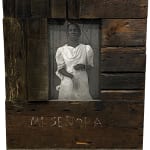

J. Roberto Diago Cuban, b. 1971
Mi Señora is a compelling work by Juan Roberto Diago that blends personal narrative, memory, and the exploration of space and identity. The piece, a lightbox made of wood, evokes the intimate feel of a window—symbolizing a threshold between the inside and outside, a private world and the outside reality. The work calls to mind the physical and emotional spaces we inhabit, particularly in relation to race, identity, and gender within the context of Cuban culture and history.
The photograph of the woman, rendered in black and white, serves as a powerful focal point within this domestic window-frame structure. The choice of monochrome tones adds a sense of timelessness and gravitas to the image, while also giving the piece a somber, introspective quality. The woman's presence in the photograph is both intimate and distant—captured in a moment of quiet contemplation, yet also framed by the boundaries of the lightbox, making her almost unreachable, like a figure from the past or a distant memory.
The title Mi Señora can be interpreted as a personal or cultural reflection on the role of women, particularly Black women, in the artist’s life and society. "Señora" refers to a woman of respect or significance, which could point to both the artist's own personal connections and the broader, often overlooked history of Black women in Cuban society. Diago’s use of the lightbox creates a layered narrative of visibility and invisibility—highlighting the woman’s image, yet keeping her suspended within the frame, as if she exists in both the tangible and the intangible realms of memory and identity.
The materiality of the lightbox itself—a work made of wood—contributes to the feeling of a constructed reality, as if the woman’s image is something that has been built or carefully preserved within the artist’s own memory or imagination. The light source behind the photograph creates a kind of halo effect, emphasizing the woman’s figure and giving her a sense of presence that contrasts with the darkness around her, invoking ideas of history, ancestry, and the passage of time.
In Mi Señora, Diago not only examines the intersection of race, gender, and memory, but also the notion of spaces—how we define them, inhabit them, and, sometimes, how they define us. The work stands as a powerful meditation on the ways in which we interact with our past, our present, and the people who shape our personal and collective histories.


